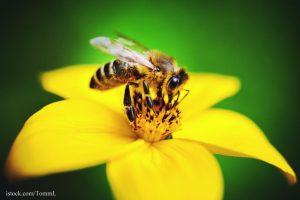Honeybees are crucial to the growth of many of the foods we eat. But their populations are in steep decline. Many experts think that neonicotinoids, a class of pesticides, are having acute and chronic effects on honeybees. These chemicals are slow to break down, meaning they build up in the environment.
 A new nationwide study released by the U.S. Geological Survey shows widespread detection of neonicotinoid insecticides in U.S. streams. At least one neonicotinoid was found in 53% of the stream samples collected around the country.
A new nationwide study released by the U.S. Geological Survey shows widespread detection of neonicotinoid insecticides in U.S. streams. At least one neonicotinoid was found in 53% of the stream samples collected around the country.
Larissa Walter, pollinator campaign director at Center for Food Safety said in a statement, “It is clear that the problems with widespread uses of neonicotinoids extend well beyond the impacts to pollinators. This study shines a light on the alarming prevalence of contamination throughout aquatic ecosystems, with ramifications that will be felt throughout entire food chains If meaningful action is not taken soon, we may be headed toward a second ‘Silent Spring’.”
Center for Food Safety says that the EPA’s benchmarks for neonicotinoid toxicity are “far too lax and fail to consider the long-term chronic impacts that neonicotinoids have on these ecosystems.” The pesticide most likely works in additive ways and has synergistic effects with other chemicals.
Neonicotinoids are applied on more than 150,000,000 acres of crop land every year in this country. Runoff flows far beyond the fields and lawns where the chemical is applied. Neonicotinoids dissolve easily in water but stay in the environment; that means they are easily transported in runoff water to surface and groundwater bodies.
Nine rivers and streams, including the Mississippi and Missouri Rivers, were included in the study. Those rivers drain most of Iowa, and parts of Minnesota, Montana, Nebraska, North Dakota, South Dakota, and Wisconsin. Those states have the highest use of neonicotinoids insecticides in the country. The chemicals were found in all nine rivers and streams.
The USGS survey states that “instead of being sprayed on growing or full-grown crops, neonicotinoids can be applied to the seed before planting.” There are higher levels of those insecticides after rain storms during crop planting, similar to the spring flushing of herbicides documented in Midwestern U.S. rivers and streams.
Environmental groups such as Friends of the Earth and Pesticide Research Institute are calling for a ban of neonicotinoids. A recent study found that 51% of garden plants bought at top garden retails in 18 cities in the U.S. and Canada contain neonicotinoid pesticides. Some of the flowers “contained nemonic levels high enough to kill bees outright assuming comparable concentrations are present in the flowers’ pollen and nectar.” No warning to consumers is on these plants.





It would be helpful to know the commercial names of these products.
Good question! Neonicotinoids are ingredients used in insecticides. The names include Acetamiprid, Clothianidin, Dinotefuran, Imidacloprid, Nitenpyram, Thiocloprid, and Thiamethoxam. Look at the label of any insecticide. If one of those names is on the list, the insecticide is a neonicotinoid.
This is no surprise the real question is what is the US EPA going to do about it? You can place all your money on nothing!